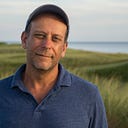Member-only story
I’m Lichen It
The Arctic Circle of Life

When you take humans out of the picture it’s amazing how quickly natural ecologies takes over. A few years ago while lecturing aboard a National Geographic cruise to Svalbard Island, I watched that process unfold in dramatic fashion. In front of me a cliff studded with bird colonies came into view. The shrieks could be heard above the breaking waves. The guano stained rocks offered up a waft of raw organic life. The birds, mostly guillimots, guarded their nests. In amongst those midsized relatives of the now extinct great awks a pair of puffins guarded their eggs and added their share of guano to the mix.

After spending three years researching a book on forage fish and the role they play in marine and terrestrial ecosystems, I’ve learned that guano is the stuff of life for nutrient poor places like Svalbard. For within guano are the concentrated nutrients of the sea brought to land. Puffins and other birds harvest fish, digest them and then excrete what is in effect a highly concentrated fertilizer. When that fertilizer settles on land it stirs life seemingly out of the very rocks as in these lichen which are known as “Ornithokoprophyllic” — literally bird-poop-loving.
But the lichen are just the first, primitive step. Further down below the cliff face, sheets of moss and some actual true plants sprouted up from the thin soil.

And feeding upon the bird fertilized moss, reindeer. From those caribou still more poop which in turn trickled down the hillside where, once it hit the water, fertilized a plankton bloom that turned the water a soupy greenish blue

In time the phytoplankton will feed zooplankton which in turn will feed fish like this sculpin lurking in the depths below the cliff face.
